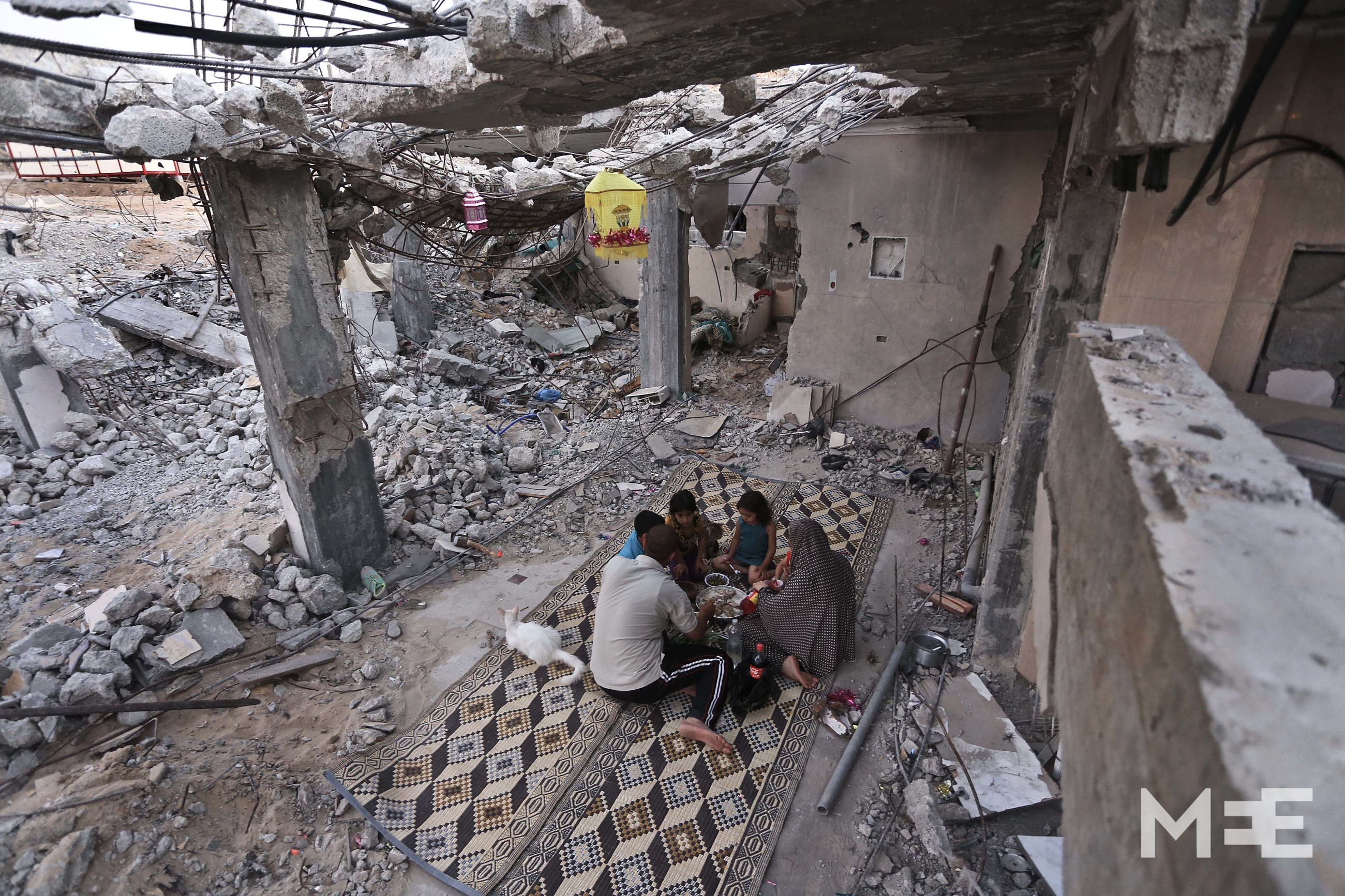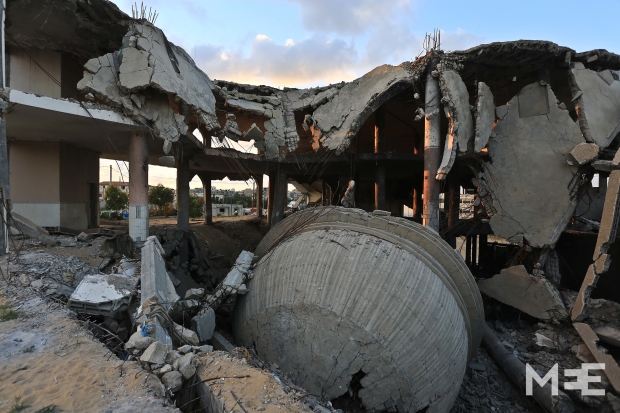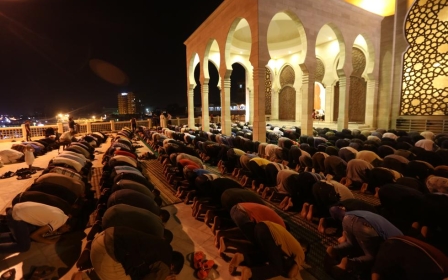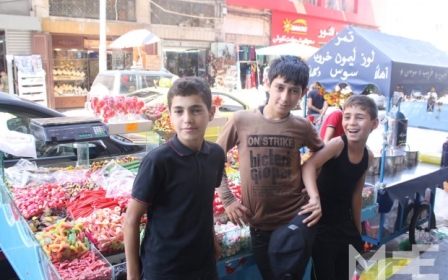Ramadan amongst the rubble of Gaza

The time for Maghreb prayers is approaching - in a few minutes all of Gaza's Muslim families will be gathering to sit around the dining table, to break their sunrise to sunset fast. It’s a time of good will, forgiveness and reflection.
For 20 years Saleh Abu Aser, 36, had been proud to honour the same annual traditions in observing the holy month of Ramadan. But this year is different. Instead of the family gathering around their comfortable living room, they now find themselves sitting on a small blanket that covers the hard, exposed ground. The family must now sit in what remains of their home, destroyed by Israel’s military assault last summer.
“This was our 300 square metre home, for 35 members of our family, and all we have left is 30 metres of ruins and rubble,” said Abu Aser, as his wife joins him with a with bowl of fresh arugula.
“I used to have a well-equipped kitchen, but now I must cook in this corner, near a wall which could collapse at any moment.”
If that wall were to collapse, the family would have nowhere to run to, and Dareen knows that taking shelter in UN-run schools and shelters has never been a safe option with Israel targeting such civilian facilities.
They took refuge in UN classrooms for months following the 51-day war in 2014.
That war killed 2,250 Palestinians, including approximately 551 children. Palestinians in Gaza are reminded of it now, after the release of the most recent UN report, stating that both Israel and Palestinians may have committed war crimes.
Yet the harsh reality on the ground does not appear to change the discussion of the leaders of the international community, and the reconstruction of Gaza, for nearly 2 million residents, seems more like a far-fetched dream, despite promises of help.
Despite all odds, the loving care of this mother for her children - Riad, eight, Tasneem, seven, Intisar, five, Maisa, three, and Ibrahim, two years-old - remains strong and steadfast, as she still manages to put simple food on the table and gather her children around her. The family gives thanks and prays for freedom to celebrate their faith and culture in peace, in their homeland.
“Ramadan is a month of blessings and joy - we are trying to keep it so, despite the dreadful conditions and unbearable stress,” said Saleh Abu Aser.
Abu Aser recalls last Ramadan with pain and agony - the month when he lost so many loved ones, when neighbours were ripped to shreds by Israeli tank shells, and his neighbourhood - Shejayeh - was turned to rubble. But what remains now, despite the nightmares, is hope for a better future.
“We are among very few families living here now. We feel isolated, but we have no other option. The international community has failed us again, with Gaza’s reconstruction," he told Middle East Eye.
“Food, daddy, food food!” demanded his son, Riad, with a smile.
After the iftar meal, Dareen Abu Aser clears the dishes and folds away the small cloth on which the family sits. She pauses for a moment and smiles as she bends forwards with a heavy stomach. Another baby expected any day.
“We have no other option but to create as normal a Ramadan as we can for our children, within the circumstances Israel has provided. This year, it means sitting on the remains of our destroyed home.”
Yesterday, the brother of Abu Aser became a father. Saleh Abu Aser hears this news from a stranger. Now that his family is scattered all over Gaza City, it is impossible to pay visits to everyone.
“In the past all of us, 35 people, would sit around one table to have our iftar meal together. But the war managed to split us up, for now." He says he has only more determination to stay alive in the place he has always loved. They may not have their dining room, but their family's resolve to stay is worth more.
“Learn to love your land, learn to love your sisters and never give up on what you stand for,” Saleh recites to his son Riad, in a moment of reflection before he prepares for tarweeh (evening prayers).
Outside his ruined home, the mosques of Shejayeh bear witness to Israel's destruction. While in previous years, these places of worship would be overflowing, this year they are in ruins and cannot be the gathering place of the faithful.
Euromid Observers for Human Rights, a rights group based in Gaza and Geneva, counted 171 mosques destroyed, of which 62 were hit mostly by Israeli air force raids during the 51-day war.
Prefabricated rooms
Khuza’a, in the south of the Gaza Strip, is the village which lived under siege during the war, experiencing several violations against human rights, including shooting from short range.
It is another day of fasting here. Just as the call for maghreb prayers begin, Ahmed Emish, 35 years old, and father to four children, stands outside on the street to enjoy some fresh air.
“We can’t get this real fresh air in our alternative, prefabricated houses, built by donor groups,” he said.
“We miss our old home and chicken farm,” said Emish, who sustained and supported his family and others, by working the poultry farm. He used to donate to charity before the war, but now he and his family survive on charity.
Mobile prefabricated homes brought much misery to homeless families in Khuza’a, and now even more so in the summer heat.
“Living in such prefabricated structures is not good, even for animals,” he explained.
There are 160 prefabricated homes in Khuza’a, where one average-size family of six such as Emish's lives in one room, where they are expected to prepare food, eat, sleep, bathe and use the toilet.
“The floor and roof are rusty and sewage water leaks into the room,” he said, describing a moment which is supposed to be lovely when the family gathers for the dawn meal or suhur.
“Water flooded into our home at 2:30 am when my wife was about to wake up and prepare the suhur meal. Sewage water covered the floor. Just imagine trying to prepare food in that,” he said.
The promises they have received from relief NGOs have not translated to facts on the ground - as families are still unfed, and children face hazardous health conditions.
The stench of the raw sewage would knock any human over, but he tries to tackle the flow, brushing it out of this tiny place. These prefabricated rooms are made for short-term refugee emergency use, after war, but now they seem to be a long-term reality if no other reconstruction is allowed. He was promised by Israel during the war that if he left his house his family would be safe. But upon their return, the house was in total ruins.
This year, “there is not much taste for Ramadan,” said a child passing by. The children have no money for the usual fireworks or party favours.
Ramadan, through the eyes of Emish, is remembered as neighbourhood mass destruction, the destruction of his farm and slaughter of his chickens under Israeli tanks and bullets - yet, when MEE asked him to recall a joyous moment from a previous Ramadan, he smiled and said:
“I remember the beautiful days, in our big garden where we would sit and have our family meal in peace, served from a large, modern, American-style kitchen.”
Middle East Eye propose une couverture et une analyse indépendantes et incomparables du Moyen-Orient, de l’Afrique du Nord et d’autres régions du monde. Pour en savoir plus sur la reprise de ce contenu et les frais qui s’appliquent, veuillez remplir ce formulaire [en anglais]. Pour en savoir plus sur MEE, cliquez ici [en anglais].








